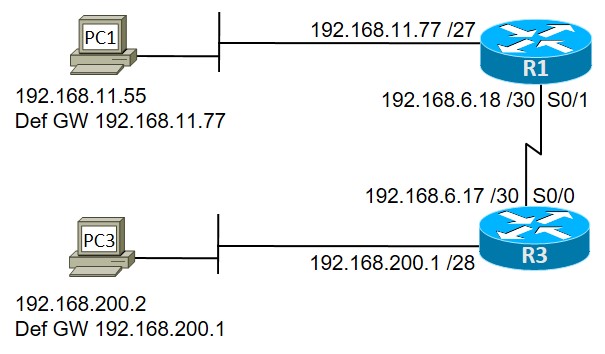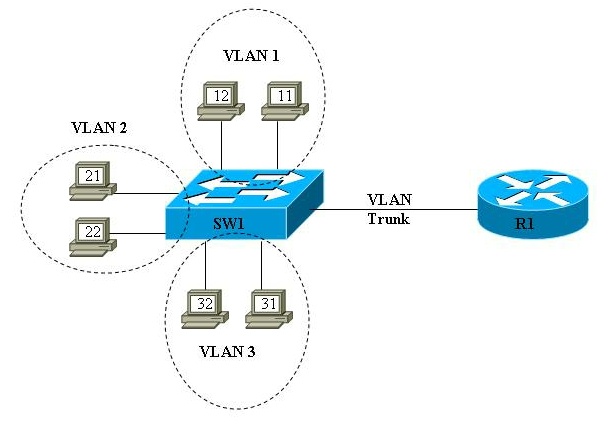A fellow engineer tells you to configure the DHCP server to lease the last 100 usable IP addresses in subnet 10.1.4.0/23. Which of the following IP addresses could be leased as a result of your new configuration?
To answer this question, you need to find the range of addresses in the subnet, which typically then means you need to calculate the subnet ID and subnet broadcast address. With subnet ID/mask of 10.1.4.0/23, the mask converts to 255.255.254.0. To find the subnet broadcast address, following the decimal process described in this chapter, you can copy the subnet ID’s first two octets because the mask’s value is 255 in each octet. You write a 255 in the fourth octet because the mask has a 0 on the fourth octet. In octet 3, the interesting octet, add the magic number (2) to the subnet ID’s value (4), minus 1, for a value of 2 + 4 − 1 = 5. (The magic number in this case is calculated as 256 − 254 = 2.) That makes the broadcast address 10.1.5.255. The last usable address is 1 less: 10.1.5.254. The range that includes the last 100 addresses is 10.1.5.155−10.1.5.254.
Which of the following is the resident subnet ID for IP address 10.7.99.133/24?
The mask converts to 255.255.255.0. To find the subnet ID, for each octet of the mask that is 255, you can copy the IP address’s corresponding values. For mask octets of decimal 0, you can record a 0 in that octet of the subnet ID. As such, copy the 10.7.99 and write a 0 for the fourth octet, for a subnet ID of 10.7.99.0.
Which of the following is the resident subnet for IP address 192.168.44.97/30?
First, the resident subnet (the subnet ID of the subnet in which the address resides) must be numerically smaller than the IP address, which rules out one of the answers. The mask converts to 255.255.255.252. As such, you can copy the first three octets of the IP address because of their value of 255. For the fourth octet, the subnet ID value must be a multiple of 4, because 256 − 252 (mask) = 4. Those multiples include 96 and 100, and the right choice is the multiple closest to the IP address value in that octet (97) without going over. So, the correct subnet ID is 192.168.44.96.
The figure shows an internetwork, with IP addresses and default gateways shown for some devices. The addresses have been configured on the routers, and the PCs have been configured using the same subnet masks as the routers on the LANs. A routing protocol has been enabled, and both routers have learned all routes known by the other router. Which statement is true about the behavior of IP in this network?

The R1 LAN subnet uses a prefix of /23, which implies a mask of 255.255.254.0, and 9 host bits. The formula for the number of hosts in a subnet is 2^9, minus 2, or a total of 510 hosts. The R1 LAN has a subnet number of 10.4.4.0 and a range of valid addresses of 10.4.4.1 through 10.4.5.254, with a subnet broadcast address of 10.4.5.255. Note that odd-looking addresses 10.4.4.255 and 10.4.5.0 are inside the range of valid IP addresses in that subnet.
Which of the following IP addresses could be assigned to a host?
Any address beginning with 127 is reserved. For 63.71.189.192/26, the number is a subnet number, with a range of valid address 63.71.189.193 through 63.71.189.254. 207.87.255.133/28 is a valid address in subnet 207.87.255.128, with a range of valid addresses from 207.87.255.129 through 207.87.255.142. For 42.16.8.11/30, the number is subnet 42.16.8.8/30’s subnet broadcast address; this subnet has a range of valid IP addresses of 42.16.8.9 and 42.16.8.10
The figure shows an internetwork, with IP addresses and default gateways for some devices. The addresses have been configured on the routers, and the PCs have been configured using the same subnet masks as the routers on the LANs. A routing protocol has been enabled, and both routers have learned all routes known by the other router. Which of the following statements are true about the behavior of IP in this network?

Please select 2 correct answers
On the top LAN, R1's LAN interface IP address of 192.168.11.77, with a /27 prefix, implies a subnet of 192.168.11.64/27, with a range of valid addresses of 192.168.11.65 - 192.168.11.94. As a result, PC1's IP address of 192.168.11.55 is in a different subnet. R3's IP address of 192.168.200.1/28 implies a subnet of 192.168.200.0/28, with a range of usable addresses from 192.168.200.1 - 192.168.200.14. PC3's IP address of 192.168.200.2 is in this range. On the serial link, the addresses and masks imply subnet 192.168.6.16/30, with a range of usable addresses from 192.168.6.17 - 192.168.6.18. As a result of the error on the top LAN, R1 would not be able to forward packets to 192.168.11.55 (PC1), because R1's connected route for the LAN subnet of 192.168.11.64/27 does not include PC1's IP address (192.168.11.55). As a result, PC3's ping of PC1 would fail.
Which of the following IP addresses could be assigned to a host?
Please select 2 correct answers
For 12.150.146.96/27, the number is the subnet number, with a range of valid IP addresses 12.150.146.97 through 12.150.146.126. For 225.16.102.232, the first octet means that the address is a multicast (Class D) address and cannot be assigned to an interface as a unicast IP address. For address 0.102.62.1, the first octet is 0, which is a reserved value. 150.159.216.202/24 is a valid address, with its subnet having a range of valid addresses 150.159.216.1 through 150.159.216.254. 214.122.127.76/26 is also a valid address, in subnet 214.122.127.64, whose range of valid addresses is 214.122.127.65 through 214.122.127.126.
Which of the following is the subnet broadcast address for the subnet in which IP address 172.31.77.201/27 resides?
The resident subnet ID in this case is 172.31.77.192. You can find the subnet broadcast address based on the subnet ID and mask using several methods. Following the decimal process in the book, the mask converts to 255.255.255.224, making the interesting octet be octet 4, with magic number 256 − 224 = 32. For the three octets where the mask = 255, copy the subnet ID (172.31.77). For the interesting octet, take the subnet ID value (192), add magic (32), and subtract 1, for 223. That makes the subnet broadcast address 172.31.77.223.
The diagram shows a small network with three VLANs. The network engineer needs to assign IP addresses to the hosts to allow them to communicate with each other. Which two of the following answers accurately describe the requirements for addressing in this small network?

Please select 2 correct answers
Hosts in the same VLAN should be in the same subnet, and hosts in different VLANs should be in different subnets. In this case, router R1 needs to route packets between the subnets/VLANs using the VLAN trunk between itself and SW1. If PC11's IP address is 10.1.1.1, mask 255.255.255.192, the subnet number is 10.1.1.0, with a range of addresses 10.1.1.1 – 10.1.1.62, which includes the suggested 10.1.1.60 IP address. For the case with PC32's IP address of 10.99.88.77, mask 255.255.252.0, PC32 would think that PC31 was in the same subnet. However, PC31's IP address of 10.99.89.78, mask 255.255.255.0, means that PC31 thinks it is in a different subnet than PC32 (range of addresses 10.99.89.0 - 10.99.89.255), which can cause problems. Generally speaking, hosts in the same subnet should use the same mask, although the hosts may be able to inefficiently communicate in some cases, even with different masks.
When thinking about an IP address using classful addressing rules, an address can have three parts: network, subnet, and host. If you examined all the addresses in one subnet, in binary, which of the following answers correctly states which of the three parts of the addresses will be equal among all addresses? (Choose the best answer.)
Which of the following statements are true regarding the binary subnet ID, subnet broadcast address, and host IP address values in any single subnet? (Choose two answers.)
Please select 2 correct answers
Share your Results:





